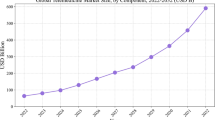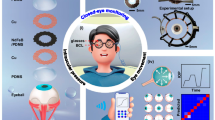Abstract
Fatigue is a complex condition characterized by a decline in a person’s mental or physical performance. Methods to gauge fatigue include self-reported questionnaires, electroencephalography and camera-based technologies. However, these methods are typically restricted to laboratory settings, which limits their wider accessibility. Here we report a soft on-eyelid magnetoelastic sensor that can capture eye-blink parameters in real time and quantitatively decode fatigue levels. The sensor, which works in a self-powered manner, comprises a magnetomechanical coupling layer formed from a silicone rubber matrix embedded with micromagnets and a conductive gold coil patterned onto a thin thermoplastic elastomer layer. This design allows the conversion of eye movements into high-fidelity electrical signals. The sensor exhibits a Young’s modulus of 200 kPa, a stretchability of up to 530% and a pressure sensitivity of 0.2 µA kPa−1. Its thin membrane structure adheres conformally to human upper eyelid tissue and maintains intimate contact during diverse eye movements. When combined with a one-dimensional convolutional neural network and data-processing techniques, the sensor can recognize subtle eye movements and categorize fatigue levels with an accuracy of 96.4% based on six eye-blink parameters.
This is a preview of subscription content, access via your institution
Access options
Access Nature and 54 other Nature Portfolio journals
Get Nature+, our best-value online-access subscription
$32.99 / 30 days
cancel any time
Subscribe to this journal
Receive 12 digital issues and online access to articles
$119.00 per year
only $9.92 per issue
Buy this article
- Purchase on SpringerLink
- Instant access to full article PDF
Prices may be subject to local taxes which are calculated during checkout




Similar content being viewed by others
Data availability
Source data are available via figshare at https://doi.org/10.6084/m9.figshare.25272598.v2 (ref. 47). Other data that support the findings of this study are available from the corresponding author upon reasonable request.
Code availability
No custom code or mathematical algorithm that was central to the conclusions was used in this study.
References
McKinley, R. A., McIntire, L. K., Schmidt, R., Repperger, D. W. & Caldwell, J. A. Evaluation of eye metrics as a detector of fatigue. Hum. Factors 53, 403–414 (2011).
Demerouti, E., Nachreiner, F., Bakker, A. B. & Schaufeli, W. B. The job demands-resources model of burnout. J. Appl. Psychol. 86, 499–512 (2001).
Boksem, M. A. S., Meijman, T. F. & Lorist, M. M. Effects of mental fatigue on attention: an ERP study. Cogn. Brain Res. 25, 107–116 (2005).
Sievertsen, H. H., Gino, F. & Piovesan, M. Cognitive fatigue influences students’ performance on standardized tests. Proc. Natl Acad. Sci. USA 113, 2621–2624 (2016).
Lorist, M. M., Boksem, M. A. S. & Ridderinkhof, K. R. Impaired cognitive control and reduced cingulate activity during mental fatigue. Cogn. Brain Res. 24, 199–205 (2005).
Sanders, A. F. Elements of Human Performance: Reaction Processes And Attention In Human Skill (Lawrence Erlbaum Associates, 1998).
Boksem, M. A. S., Meijman, T. F. & Lorist, M. M. Mental fatigue, motivation and action monitoring. Biol. Psychol. 72, 123–132 (2006).
Chattu, V. K. et al. The global problem of insufficient sleep and its serious public health implications. Healthcare 7, 1–16 (2019).
Hockey, G. R. J., Maule, A. J., Clough, P. J. & Bdzola, L. Effects of negative mood states on risk in everyday decision making. Cogn. Emot. 14, 823–855 (2000).
Li, J. et al. Evaluating the impact of mental fatigue on construction equipment operators’ ability to detect hazards using wearable eye-tracking technology. Autom. Constr. 105, 102835 (2019).
Higgins, J. S. et al. Asleep at the wheel-the road to addressing drowsy driving. Sleep 40, zsx001 (2017).
Penner, I. & Paul, F. Fatigue as a symptom or comorbidity of neurological diseases. Nat. Rev. Neurol. 13, 662–675 (2017).
Caffier, P. P., Erdmann, U. & Ullsperger, P. Experimental evaluation of eye-blink parameters as a drowsiness measure. Eur. J. Appl. Physiol. 89, 319–325 (2003).
Frey, M., Nau, M. & Doeller, C. F. Magnetic resonance-based eye tracking using deep neural networks. Nat. Neurosci. 24, 1772–1779 (2021).
Cori, J. M., Anderson, C., Soleimanloo, S. S., Jackson, M. L. & Howard, M. E. Narrative review: do spontaneous eye blink parameters provide a useful assessment of state drowsiness? Sleep Med. Rev. 45, 95–104 (2019).
Paprocki, R. & Lenskiy, A. What does eye-blink rate variability dynamics tell us about cognitive performance?. Front. Hum. Neurosci. 11, 620 (2017).
Shi, Y. et al. Eye tracking and eye expression decoding based on transparent, flexible and ultra-persistent electrostatic interface. Nat. Commun. 14, 3315 (2023).
Homayounfar, S. Z. et al. Multimodal smart eyewear for longitudinal eye movement tracking. Matter 3, 1275–1293 (2020).
Villari, E. Ueber die Aenderungen des magnetischen Moments, welche der Zug und das Hindurchleiten eines galvanischen Stroms in einem Stabe von Stahl oder Eisen hervorbringen. Ann. Phys. 202, 87–122 (1865).
Clark, A. E. High power rare earth magnetostrictive materials. J. Intell. Mater. Syst. Struct. 4, 70–75 (1993).
Clark, A. E., Wun-Fogle, M., Restorff, J. B. & Lograsso, T. A. Magnetostrictive properties of galfenol alloys under compressive stress. Mater. Trans. 43, 881–886 (2002).
Zhou, Y. et al. Giant magnetoelastic effect in soft systems for bioelectronics. Nat. Mater. 20, 1670–1676 (2021).
Zeng, Z. Y., Hu, C. E., Chen, X. R., Cai, L. C. & Jing, F. Q. Magnetism and phase transitions of iron under pressure. J. Phys.: Condens. Matter 20, 425217 (2008).
Kinloch, I. A., Suhr, J., Lou, J., Young, R. J. & Ajayan, P. M. Composites with carbon nanotubes and graphene: an outlook. Science 362, 547–553 (2018).
Kim, D. H. et al. Epidermal electronics. Science 333, 838–843 (2011).
Yuk, H. et al. 3D printing of conducting polymers. Nat. Commun. 11, 1604 (2020).
Jiang, Y. et al. A universal interface for plug-and-play assembly of stretchable devices. Nature 614, 456–462 (2023).
Huang, X. et al. Transient, implantable, ultrathin biofuel cells enabled by laser-induced graphene and gold nanoparticles composite. Nano Lett. 22, 3447 (2022).
Wang, C. et al. Monitoring of the central blood pressure waveform via a conformal ultrasonic device. Nat. Biomed. Eng. 2, 687 (2018).
Li, J. et al. Ultrathin, soft, radiative cooling interfaces for advanced thermal management in skin electronics. Sci. Adv. 9, adg1837 (2023).
Kuwabara, T., Cogan, D. G. & Johnson, C. C. Structure of the muscles of the upper eyelid. Arch. Ophthalmol. 93, 1189–1197 (1975).
Feig, V. R., Tran, H., Lee, M. & Bao, Z. Mechanically tunable conductive interpenetrating network hydrogels that mimic the elastic moduli of biological tissue. Nat. Commun. 9, 2740 (2018).
Lee, G. H. et al. Rapid meniscus-guided printing of stable semi-solid-state liquid metal microgranular-particle for soft electronics. Nat. Commun. 13, 2643 (2022).
Mates, J. E., Bayer, I. S., Palumbo, J. M., Carroll, P. J. & Megaridis, C. M. Extremely stretchable and conductive water-repellent coatings for low-cost ultra-flexible electronics. Nat. Commun. 6, 8874 (2015).
Liu, S., Rao, Y., Jang, H., Tan, P. & Lu, N. Strategies for body-conformable electronics. Matter 5, 1104–1136 (2022).
Handorf, A. M., Zhou, Y., Halanski, M. A. & Li, W. J. Tissue stiffness dictates development, homeostasis, and disease progression. Organogenesis 11, 1–15 (2015).
Sergeeva, A., Vikulina, A. S. & Volodkin, D. Porous alginate scaffolds assembled using vaterite CaCO3 crystals. Micromachines 10, 357 (2019).
Solazzo, M., O’Brien, F. J., Nicolosi, V. & Monaghan, M. G. The rationale and emergence of electroconductive biomaterial scaffolds in cardiac tissue engineering. APL Bioeng. 3, 041501 (2019).
Seddiki, K. et al. Cumulative learning enables convolutional neural network representations for small mass spectrometry data classification. Nat. Commun. 11, 5595 (2020).
Hannun, A. Y. et al. Cardiologist-level arrhythmia detection and classification in ambulatory electrocardiograms using a deep neural network. Nat. Med. 25, 65–69 (2019).
Kuwahara, A., Nishikawa, K., Hirakawa, R., Kawano, H. & Nakatoh, Y. Eye fatigue estimation using blink detection based on eye aspect ratio mapping (EARM). Cogn. Robotics 2, 50–59 (2022).
Shahid, A., Wilkinson, K., Marcu, S. & Shapiro, C. M. in STOP, THAT and One Hundred Other Sleep Scales (Shahid, A. et al.) 369–370 (Springer, 2011).
Shahid, A., Wilkinson, K., Marcu, S. & Shapiro, C. M. in STOP, THAT and One Hundred Other Sleep Scales (Shahid, A. et al.) 209–210 (Springer, 2011).
Che, Z. et al. Speaking without vocal folds using a machine-learning-assisted wearable sensing-actuation system. Nat. Commun. 15, 1873 (2024).
Quirk, T. J. Excel 2007 for Educational and Psychological Statistics 163–179 (Springer, 2012).
Abdi, H. & Williams, L. J. Principal component analysis. Wiley Interdiscip. Rev.: Comput. Stat. 2, 433–459 (2010).
Xu, J. et al. Source data. figshare https://doi.org/10.6084/m9.figshare.25272598.v2 (2025).
Acknowledgements
J.C. acknowledges the Vernroy Makoto Watanabe Excellence in Research Award at the UCLA Samueli School of Engineering, the Office of Naval Research Young Investigator Award (Award ID N00014-24-1-2065), a National Institutes of Health grant (Award ID R01 CA287326), a National Science Foundation grant (Award No. 2425858), an American Heart Association Innovative Project Award (Award ID 23IPA1054908), an American Heart Association Transformational Project Award (Award ID 23TPA1141360), the American Heart Association’s Second Century Early Faculty Independence Award (Award ID 23SCEFIA1157587) and the NIH National Center for Advancing Translational Science UCLA CTSI (Grant No. KL2TR001882).
Author information
Authors and Affiliations
Contributions
J.C. conceived the idea and supervised the whole project. J.X. and C.D. designed the experiment and fabricated the device. X.W. and Z.C. assisted in the testing the performance of the device. J.X., C.D. and T.T. wrote the paper. X.Z., Y.Z. and J.Y. assisted in designing the figures. S.L. and Y.S. provided support on the cell viability assay. All authors have read the paper, agree with its contents and approved submission.
Corresponding author
Ethics declarations
Competing interests
J.C. and J.X. have filed a patent from the University of California, Los Angeles. The remaining authors declare no competing interests.
Peer review
Peer review information
Nature Electronics thanks Guosong Hong, Shiyuan Wei and the other, anonymous, reviewer(s) for their contribution to the peer review of this work.
Additional information
Publisher’s note Springer Nature remains neutral with regard to jurisdictional claims in published maps and institutional affiliations.
Supplementary information
Supplementary Information
Supplementary Figs. 1–43, Notes 1–5 and Tables 1–5.
Supplementary Video 1
Actual appearance of the 3UM on-eyelid sensor.
Supplementary Video 2
3UM on-eyelid sensor for fatigue detection and management.
Rights and permissions
Springer Nature or its licensor (e.g. a society or other partner) holds exclusive rights to this article under a publishing agreement with the author(s) or other rightsholder(s); author self-archiving of the accepted manuscript version of this article is solely governed by the terms of such publishing agreement and applicable law.
About this article
Cite this article
Xu, J., Duan, C., Wan, X. et al. A soft magnetoelastic sensor to decode levels of fatigue. Nat Electron 8, 709–720 (2025). https://doi.org/10.1038/s41928-025-01418-x
Received:
Accepted:
Published:
Issue date:
DOI: https://doi.org/10.1038/s41928-025-01418-x



